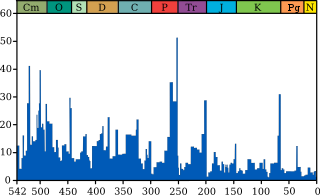This is a list of extinction events, both mass and minor:[1]
"Big Five" major extinction events (see graphic)
| Period or supereon | Extinction | Date | Probable causes[2] |
|---|---|---|---|
| Quaternary | Holocene extinction | c. 10,000 BC – Ongoing | Humans[3] |
| Quaternary extinction event | 640,000, 74,000, and 13,000 years ago |
Unknown; may include climate changes, massive volcanic eruptions and Humans (largely by human overhunting)[4][5][6] | |
| Neogene | Pliocene–Pleistocene boundary extinction | 2 Ma | Possible causes include a supernova[7][8] or the Eltanin impact[9][10] |
| Middle Miocene disruption | 14.5 Ma | Climate change due to change of ocean circulation patterns. Milankovitch cycles may have also contributed[11] | |
| Paleogene | Eocene–Oligocene extinction event | 33.9 Ma | Multiple causes including global cooling, polar glaciation, falling sea levels, and the Popigai impactor[12] |
| Cretaceous | Cretaceous–Paleogene extinction event | 66 Ma | Chicxulub impactor; the volcanism which resulted in the formation of the Deccan Traps may have contributed.[13] |
| Cenomanian-Turonian boundary event | 94 Ma | Most likely underwater volcanism associated with the Caribbean large igneous province, which would have caused global warming and acidic oceans[14] | |
| Aptian extinction | 117 Ma | Unknown, but may be due to volcanism of the Rajmahal Traps[15] | |
| Jurassic | End-Jurassic (Tithonian) | 145 Ma | No longer regarded as a major extinction but rather a series of lesser events due to bolide impacts, eruptions of flood basalts, climate change and disruptions to oceanic systems[16] |
| Pliensbachian-Toarcian extinction (Toarcian turnover) | 186-178 Ma | Formation of the Karoo-Ferrar Igneous Provinces[17] | |
| Triassic | Triassic–Jurassic extinction event | 201 Ma | Possible causes include gradual climate changes, volcanism from the Central Atlantic magmatic province[18] or an impactor[19] |
| Carnian Pluvial Event | 230 Ma | Wrangellia flood basalts,[20] or the uplift of the Cimmerian orogeny | |
| Olenekian-Anisian boundary event | 247 Ma | Ocean acidification[21] | |
| Smithian-Spathian boundary event | 249 Ma | Late eruptions of the Siberian Traps | |
| Griesbachian-Dienerian boundary-event | 252 | Late eruptions of the Siberian Traps[22] | |
| Permian | Permian–Triassic extinction event | 252 Ma | Large igneous province (LIP) eruptions [23] from the Siberian Traps,[24] an impact event (the Wilkes Land Crater),[25] an Anoxic event,[26] an Ice age,[27] or other possible causes |
| End-Capitanian extinction event | 260 Ma | Volcanism from the Emeishan Traps,[28] resulting in global cooling and other effects | |
| Olson's Extinction | 270 Ma | Unknown.[29][30][31] Possibly a change in climate, but evidence for this is weak.[32]. This event may actually be a slow decline over 20 Ma.[33] | |
| Carboniferous | Carboniferous rainforest collapse | 305 Ma | Possiblities include a series of rapid changes in climate, or volcanism of the Skagerrak-Centered Large Igneous Province[34] |
| Serpukhovian extinction | ~ 325 Ma | Onset of the Late Paleozoic icehouse | |
| Devonian | Hangenberg event | 359 Ma | Anoxia, possibly related to the Famennian glaciation or volcanic activity, Supernova[35] |
| Late Devonian extinction (Kellwasser event) | 372 Ma | Viluy Traps;[36] Woodleigh Impactor?[2] | |
| Taghanic Event | ~384 Ma | Anoxia | |
| Kačák Event | ~388 Ma | Anoxia | |
| Silurian | Lau event | 420 Ma | Changes in sea level and chemistry?[37] |
| Mulde event | 424 Ma | Global drop in sea level?[38] | |
| Ireviken event | 428 Ma | Deep-ocean anoxia;[39] Milankovitch cycles?[40] | |
| Ordovician | Late Ordovician mass extinction | 445-444 Ma | Global cooling and sea level drop, and/or global warming related to volcanism and anoxia[41] |
| Cambrian | Cambrian–Ordovician extinction event | 488 Ma | Kalkarindji Large Igneous Province?[42] |
| Dresbachian extinction event | 502 Ma | ||
| End-Botomian extinction event | 517 Ma | ||
| Precambrian | End-Ediacaran extinction | 542 Ma | Anoxic event[43] |
| Great Oxygenation Event | 2400 Ma | Rising oxygen levels in the atmosphere due to the development of photosynthesis as well as possible Snowball Earth event. (see: Huronian glaciation.) |

